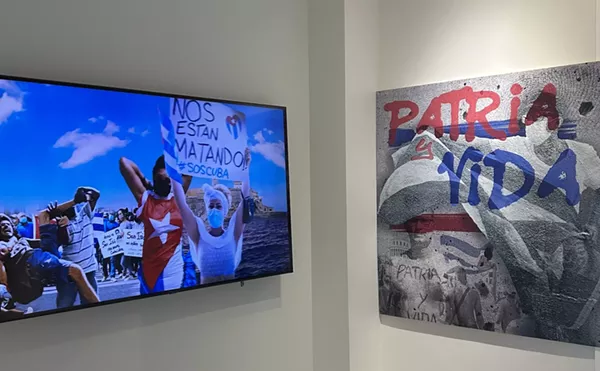Inside the gallery, Sikander's miniature drawings on twelve-by-nine-inch sheets beckon viewers toward their glass frames. Only at this proximity do you notice the sagging and twisted tongues of leaping fawn or the hundreds of precise vertical strokes within one of her solid black rectangles.
The artworks' tiny, perfect lines imply a laborious art-making process, one that requires an impressive combination of patience and obsession.
Fifty-one drawings hang side by side on the New Work Gallery's four white walls. Viewed in succession, the works form a series in which each piece seems loosely formed from the last.
As your gaze skips down the row of silver frames, the drawings' ink and graphite splats and slashes appear to change from simple geometric forms — sixteen black circles or a shaded gray disk — into intricate patterns of foliage and frolicking woodland animals.
An arabesque garland suddenly jumps out, bordering a black rectangle. The garland teasingly overlaps the dark center, and then whoosh! — from the darkness emerges a swarm of amputated black octopi, each a centimeter in size, like bats flying toward a full moon.
Born in Lahore, Pakistan, in 1969, Sikander attended the National College of Art in Lahore, where she studied Indian miniature painting, specifically that of the Mughul Empire. An antiquated genre, Indian miniature painting reached its pinnacle of artisanship between the Sixteenth and Eighteenth centuries, a time when Muslim rulers from Persia reigned over the predominantly Hindu nation of India. In India and Pakistan today, miniature works are predominantly sold as cheap souvenirs, tainting the perception of the genre.
Most of the students at the National College of Art in Lahore viewed the miniature program as outdated, Sikander recalls. She herself had grown up believing the art form was clichéd and kitschy, yet she recognized its potential for subversion.
Through her studies, Sikander developed an understanding of the conceptual significance and complex symbolism of Indian miniatures. Using this tradition as a base, she began infusing it into twentieth-century and Western iconography.
Sikander's creative world is a grab bag of loaded imagery: griffins, turbans, angels, and soccer balls. She naturally weaves images from Western pop culture with three different styles of Indian painting: the sensual Hindu designs of the Rajput School; the women-centered format of the Kangra Valley; and the naturalism of the Mughal Empire.
A magnifying glass would be a helpful viewing accouterment and would allow the viewer to fully grasp the sensitivity of line and shading in the drawings. Each teeny face Sikander draws is distinctive and full of emotion; even strands of facial hair appear to be full of life.
Throughout the course of the suite, symbolic images take on an abbreviated form and eventually lose their original significance. For example, an Arabic man disappears, leaving only his turban, and a Gopi (a female lover of the Hindu god Krishna) emerges as merely a distinct hairstyle.
Sikander frequently cites Jacques Derrida's deconstructionist philosophies in relationship to her work's conceptual premise. In particular, Sikander muses on Derrida's theory of binary opposites. According to the controversial French thinker, the act of defining polar opposites creates hierarchy in society. Following this theory, Sikander juxtaposes and abstracts images that represent such opposing ideas, including east and west, white and black, or modern and traditional. In doing so, she attempts to break down the viewer's preconceived associations and demonstrate that such assumptions and categorizations are ultimately meaninglessness: A soccer ball becomes a circle. A square becomes an elephant.
Of the suite, Sikander remarks simply: "They were created from humble beginnings with a heavy dose of imagination."
When does a man become a woman? When does Western become Eastern? Sikander's work unveils the superficial nature of boundaries and suggests a universal flow.
The flying objects initially perceived as amputated octopi are actually stylized Gopi hairdos. Alas, the mistake is insignificant. The objects could be labeled Gopi hairdos or amputated octopi and the strength of the drawing would not falter.
According to Sikander, finding meaning in her work is of secondary concern, perhaps even arbitrary. She intentionally adulterates visual information in order to blur a linear narrative, thus toying with a viewer's natural inclination to categorize. Any symbolism or story line perceived is a product of the viewer's own enculturation.
Over the past few years, Sikander has begun to dabble in animation. MAM's current exhibit features two of her works in this medium: Pursuit Curve and Dissonance to Detour. Both videos are two-dimensional collages created by scanning drawings into the computer and using software to add effects and motion.
Conceptually, animation allows Sikander to further defy the boundaries of tradition. Furthermore, introducing motion allows Sikander to directly fuse recognizable images with abstracted forms. In contrast, a relationship between objects is merely implied in her drawings.
Pursuit Curve, which Sikander completed during the making of 51 Ways of Looking, opens with a solid red circle. The red begins to break up, pieces undulated with increasing volatility. The crazed buzzing fragments then land on the heads of Arabic men and tag themselves as turbans. The turbans and men morph into craggy mountains, which then give way to bursts of color that contrast with the night sky behind. Night turns to day, and a tree-covered hill appears. The turbans return to accumulate under the hill and are eventually covered with roots or veins.
The morphing figures and shapes clearly show the path from definition to abstraction, thus connecting the objects to ideas of deconstruction and universal flow.
Nonetheless, Sikander's video works lack the stunning delicacy of her drawings. In abandoning the tangible materials of paper and pigment to pursue the conceptual nature of animation, her images lose the empowering subtly of lighting and line, in turn weakening their aesthetic impact.












